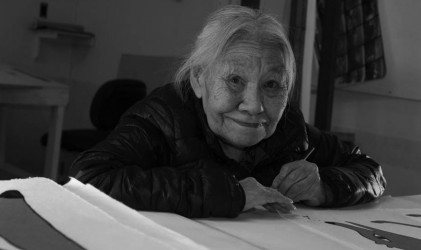Article Origin
Volume
Issue
Year
Draw, draw, draw and then draw some more
As lung cancer sapped the strength of Inuit artist Kenojuak Ashevak, best known for her colorful image of The Enchanted Owl first produced on Canada’s 1970 six cent stamp, she unfalteringly created art.
“There she would be on her mattress, lying on her stomach, drawing, drawing, drawing,” said nephew Tim Pitsiulak. “Northern houses become cold quickly and the heat is not always there” so bed was the best place for the frail Ashevak, who passed away Jan. 7 at 85.
“Few people have witnessed her process as I have, and for that I’m eternally on cloud nine,” said the 45-year-old Pitsiulak, whose artwork is sought after and who artistically leads his generation, though his work differs greatly from his aunt’s. Where Ashevak captured the enigmatic spirit of the natural world, Pitsiulak documents modern Inuit life, as in his drawing of a family of eight flying down the road on an all-terrain vehicle.
“My aunt definitely had the gift. She had such a special way of seeing the people and animals she liked to draw. She would sit and look at the blank paper, and then whatever was in her head came out.”
Observers say Ashevak’s hand was impeccably sure, and she never used an eraser.
“She encouraged me to sit before that blank paper, no matter how hard it was, and let something come. Maybe we didn’t talk so much, but her message was to continue drawing. From her I learned good work ethic. Even if life is hard, keep drawing.”
Life wasn’t always easy for Ashevak. Born in an igloo in Ikerrasak in 1927, a campsite on south Baffin Island, she endured rapid change in her community’s nomadic lifestyle when the federal government forced relocation to Cape Dorset.
She gave birth to seven children, adopted seven more, and was taken as a young mother against her will to a Quebec hospital to be treated for tuberculosis for several years, leaving her family behind. Some of her children died while she was away yet her spirit remained resilient.
One of the outsiders helping her people to adjust to a more sedentary existence was government administrator James Houston, who saw a way for Inuit to make money from their art. When he first met Ashevak in 1958, he enquired about an appliqué design on her sealskin bag. She explained it was of a rabbit thinking about eating seaweed.
He asked her to draw it on paper with a pencil, and then he traced it onto a stencil. Rabbit Eating Seaweed became her first print.
After that, she regularly brought drawings into the locally-owned West Baffin Eskimo Co-operative to be made into prints. She outlined her subjects in pencil and ink, and tinted them with coloured pencil. In her early work she liked to feature women in traditional parkas and leggings interacting with birds and foxes as they moved across the land.
Toronto art dealer Pat Feheley, of Fehely Fine Arts, has known Ashevak since 1968. She flew to Cape Dorset for the funeral and said about 500 people attended. “It was a beautiful ceremony. She was such an inspiration for generations of artists. She was buried beside her first husband Johnniebo.”
It was with him that Ashevik travelled to Japan when the two of them were asked to paint a mural for the Canadian Pavilion at the 1970 World’s Fair in Osaka. She showed works in Europe and the United States; received honorary doctorates from Queen’s University and the University of Toronto; and in 2008 received the Governor General’s Award in Visual and Media Arts.
Daughter Silaqqi described the occasion of her mother’s earning of a star on Canada’s Walk of Fame in Toronto.
“There were so many people. Everyone was crowding around her. Back here in Cape Dorset, she’s just my mom. She was a very small, happy woman. Even though she was small, she could tackle anything.”
Silaqqi noted her mother was a storyteller who often told of the days of living in snow houses. She encouraged her community, especially young people, to preserve Inuit values, traditions and the Inuktitut language, and to stay in school.
Approaching her late 70s, Ashevak branched out from creating prints and designed a stained-glass work for the Appleby College chapel in Oakville, Ont. in the mid-2000s. Two years ago, she began making large scale drawings in her tiny home, literally filling it with six foot by eight foot drawings.
In her bio on the Fehely Fine Arts Web site, Ashevak is quoted as saying: “My work has changed quite a bit since I started. At first, it was just in pencil; there was no colour. When I’m doing graphic work, sometimes I have to hold the paper and look at it and feel it, and then the work starts to come out,” she explained. Of the carvings she once made she said: “It’s easier to do the carvings because you can see the shape three dimensionally before it’s formed. ... but I prefer to work on drawings; the stone can be hard, and you have to be outside carving.”
Her art is described on the Web site as imagery which “emphasizes motifs of nature and places design above strict concerns for realism. Her steady hand traces a fluid line where positive and negative space interact.”
Of all the remarkable Inuit artists who helped Canada gain its identity in the 60s when Inuit art and artists became globally appreciated, Ashevak is probably the best known and most acclaimed, according to a story on Canadian Art’s Web page. Her drawings anchored the famed annual collection of prints from Cape Dorset between 1959 and 2012 and are now valued as high as $25,000. She survived all of her 1959 exhibition cohorts, and may be the last renowned Inuit artist born and raised on the land.
- 14099 views

